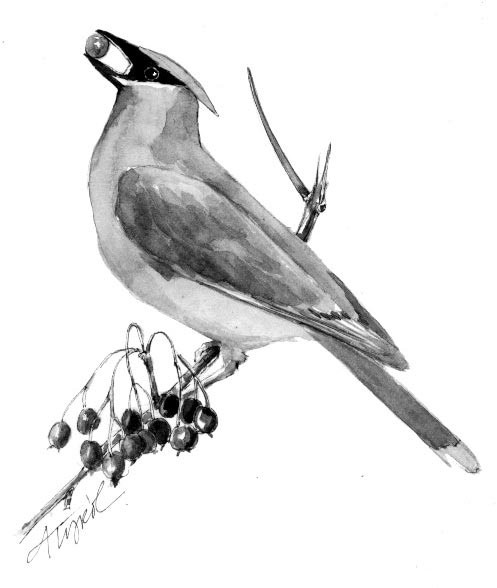
It’s May and my first year in Vermont. I look out my office window to see a flock of robins land in the staghorn sumac trees that line the backyard. Before I can think, “Spring is here,” a snow squall hits. Through the driving snow, I see the robins pulling seeds out of the fuzzy, brownish red sumac seed clusters – now dusted with white snow – and eating them.
Seven years later, it’s the first week in April. I walk out of the hospital holding my newborn son in my arms. Frenzied motion on my left attracts my attention. A small tree is covered in small, red fruit – crabapples, I think. Each small, red orb carries a white cap of snow. There is a cedar waxwing on every branch, attacking the fruit.
It’s February, some year in between. I’m riding a chairlift at a ski resort when a flash of reddish orange in a tree catches my eye. The color is so intense that at first I can’t figure out what it is. But as the chairlift gets closer, I see it is a huge mass of berries, bowed low from the weight of the snow. There are more berry clumps in the tree, and more still in another tree several yards away. I’ve ridden this chairlift dozens, if not hundreds of times before; why haven’t I noticed these mountain ashes and their clusters of bright berries?
And why haven’t our winter-resident birds (such as crows, blue jays, purple finches, and grouse) noticed them either? It turns out that our local birds haven’t exactly missed these clumps of flame-colored berries here or there; instead, they seem to turn up their bills at these berries, which look tasty enough to us humans. These berries often feed fall-migrant birds, but if they don’t, they are often passed over by our winter birds only to end up feeding the northbound migrant birds in the spring.
Of course, this depends on many factors. If there is a shortage of the winter nuts, cones, and berries that our year-rounders usually favor, our birds will help themselves to berries they usually disdain. What caught my eye is how frequently these second-tier, often-bypassed berries are red.
Mountain ash, highbush cranberry, winterberry, mountain holly: all have red berries that you may very well see hanging around all winter. Don’t be fooled by winterberry and mountain holly, our two native hollies. They are deciduous (losing their leaves in fall) unlike the celebrated European holly of Christmas fame, and their red berries stand alone on the twig as winter arrives.
But no plant suddenly sprouts red berries in midwinter. Late summer and fall are filled with red berries, but only some of them hang on. Which berries last through the fall, into the winter, and even into the spring, depends a little bit on planning and a little bit on luck.
Bernd Heinrich’s book, Winter World, offers the best explanation I’ve found for why some berries endure longer than others. Sweet, juicy berries are quickly gobbled up by birds heading south and by bears fattening themselves for the winter. The berries that remain are described as “dry,” “acidic,” “bitter,” or some combination of those. Our winter-resident birds avoid this meager fare when they can afford to.
But there is a luck factor, too, in which red berries persist. Heinrich describes his highbush cranberries lasting through the winter unless there is a waxwing invasion. (These birds tend to come to our area in winter either in large numbers or not at all.) Heinrich also describes the plants that grow these berry survivors as “stingy.” They are stingy with juice and stingy with sugar. And there is probably no stingier berry than that of the staghorn sumac. These berries are so fuzzy and so lean that they seem more likely to be spread by the wind than by the eat-and-poop method most berry plants use.
Many of our red-berried shrubs are among the first trees that grow up when an agricultural field is abandoned, including sumacs, hawthorns, chokecherries, and pin cherries. Could it be that the overall strategy of these shrubs is to avoid having their berries eaten by our local residents in winter so as to hitch a ride in the spring with the long-distance (and hungrier) migrants, who have a better chance of giving their seed a lift to newly abandoned pastures farther afield?
In any event, keep an eye out for red berries as winter gives way to spring. Because, while there may be nothing more symbolic of spring than a robin pulling up an earthworm, in a May snowstorm, it may be these red berries of winter that provide the only buffet in town.

